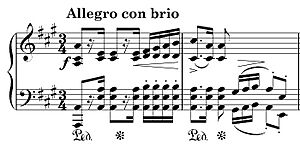Polonaises Op. 40 (Chopin) facts for kids
The Polonaise in A major, Op. 40, No. 1 is a famous piece of music for solo piano. It is often called the "Military" Polonaise. The great composer Frédéric Chopin wrote it. This piece was released in 1838, along with another polonaise, the Polonaise in C minor, Op. 40, No. 2. Another famous musician, Anton Rubinstein, once said that the A major Polonaise shows the glory of Poland. He felt the C minor Polonaise showed Poland's sadness.
What is a Polonaise?
A polonaise is a traditional Polish dance. It has a special rhythm and is played in 3/4 time, like a waltz. Chopin's "Military" Polonaise follows this rhythm very closely.
About the Music
This polonaise is written in a common musical form called A-B-A. This means it has a main section (A), then a different middle section called a "Trio" (B), and then it goes back to the main section (A).
The piece starts with a strong A major chord. It sounds very powerful and energetic. The music's speed is marked as Allegro con brio, which means "Fast, with bravura." This tells the player to play it quickly and with a lot of spirit.
The Trio Section
The middle part, or trio section, begins in D major. This part has a unique sound. After the first part of the trio, there's a short passage with trills. Trills are quick, repeating notes. Here, both hands play trills on low C-sharps, an octave apart. These trills sound a lot like drum rolls, which adds to the "military" feel of the piece.
Meaning and Impact
Many composers before Chopin, like Bach, Mozart, and Beethoven, also wrote polonaises. However, music experts like Charles Rosen have noted that Chopin's "military" polonaises were different. They had a strong, powerful feeling that was new.
These pieces were seen as more than just music. They were understood as a way to show patriotism for Poland. At the time, Poland was fighting for its freedom. So, these "military" polonaises became very popular and were a symbol of national pride.
See also
 In Spanish: Polonesas, Op. 40 (Chopin) para niños
In Spanish: Polonesas, Op. 40 (Chopin) para niños


